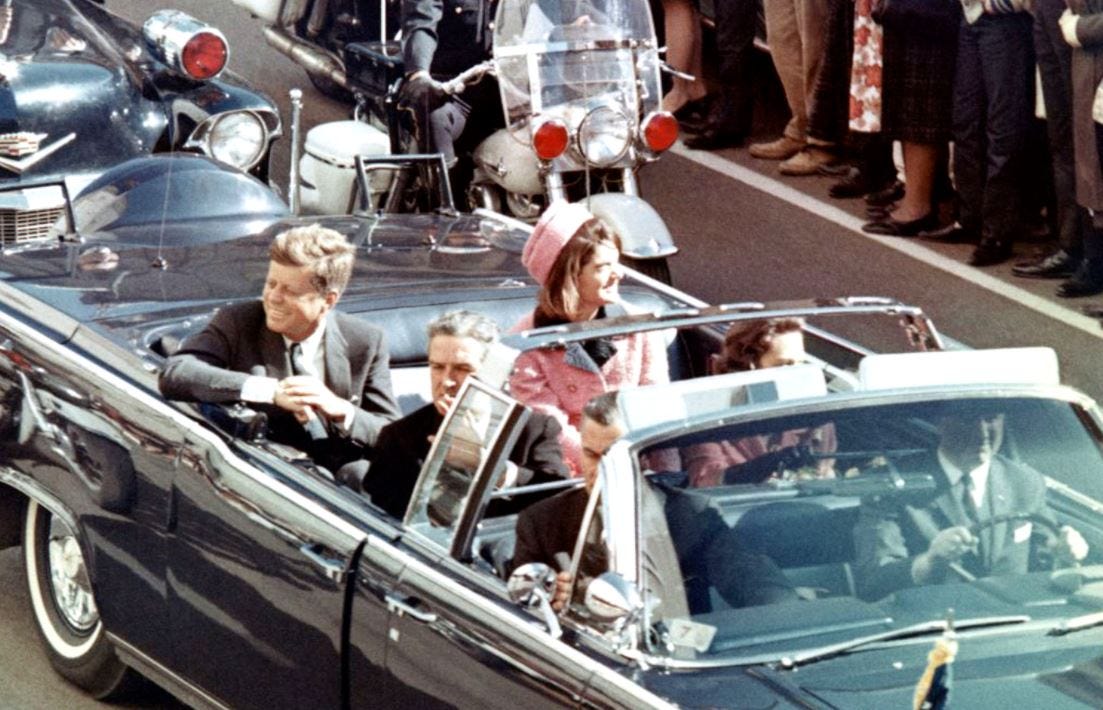TDIH: JFK shot & the toll on Jackie
You know the many controversies surrounding the story of JFK’s assassination, but do you know what happened to Jackie Kennedy in the days and weeks after his death?
On this day in 1963, President John F. Kennedy is shot and killed in Dallas, Texas.
You’ve heard the story many times, and you know the many controversies surrounding the story of JFK’s assassination. But do you know what happened to Jackie Kennedy in the days and weeks after his death?
The First Lady was there when the President was killed, of course. She famously stood next to Lyndon B. Johnson when he took the presidential oath of office on Air Force One. She was still wearing the blood-stained pink suit that she’d been wearing all day.
“I want them to see what they have done to Jack,” she told Lady Bird Johnson.
When Jackie returned home, she was immediately confronted with many decisions, both big and small. For one thing, JFK’s funeral had to be planned. Jackie decided that he should be buried in Arlington National Cemetery, not in Massachusetts. “He belongs to the people,” she said. She arranged for an eternal flame to be lit near JFK’s grave.
Jackie was still grieving an infant son who had died that summer. She arranged for Patrick Kennedy’s body to be moved to Arlington, next to his father. She also moved their little daughter, Arabella, who had been stillborn in 1956.
How heart-wrenching to watch those two little caskets join the larger one for their father?
But her living children needed attention, too. Little John’s 3rd birthday was on the same day as his father’s funeral. Caroline’s 6th birthday occurred only two days later. They had been attending school in the White House, but now they would no longer be allowed to live there. What were they to do?
Lady Bird offered to keep the school open, at least for a little while.
Jackie also had to choose a new home, of course. She settled on a place in Georgetown, but it must have been hard to find solace there. Throngs of reporters and well-wishers were always gathering outside her front door, and the drapes had to be kept closed so no one could see the grieving family inside.
In the meantime, Jackie felt responsible for preserving JFK’s legacy and influencing what historians would say about him. One week after his death, she called a reporter from Life magazine. She wanted him to write an article. When the reporter arrived, she spoke for hours. “She wanted to make certain that Jack was not forgotten in history,” the reporter later said.
Jackie told the reporter a story of an old song that she said JFK loved. The song concluded with the line: “Don’t let it be forgot, that once there was a spot, for one brief, shining moment that was known as Camelot.”
The Life article appeared a week later. As you know, the Camelot analogy stuck.
But there was still more. Decisions kept confronting Jackie. Who should write the authoritative account of JFK’s assassination? What should she say to the Warren Commission? Maybe worse, she had to listen to constant speculation about who had killed her husband.
“[W]hat did it matter what they found out?” she said. “They could never bring back the person who was gone.”
Throughout all this time, as one historian speculates, she may have been suffering from post-traumatic stress disorder. She would stay up late, crying and drinking. She relived the critical moments over and over in her head. Could she have pushed the President out of the way? She considered suicide, but knew that her children needed her. She smoked compulsively.
For a while, the brave face that she presented to the public was exactly that—a brave face. It would be many years before she ever really set her life to rights again.
Although maybe she never really felt that she did? As she told the Life magazine reporter in 1963: “There’ll never be another Camelot.”
Sources can always be found on my website, here.





I will never forget that day! I remember where I was, the reactions of my teacher and the news reports during the weekend. I was very young, but it had a big effect on me. It was the saddest funeral. I thought of Jackie and the two children with sorrow. It was a terrible time in our history. A few years ago we visited Dallas and toured the library museum where Oswald shot Kennedy. It has an eerie feel to it even after all the years.
Thanks for telling Jackie’s story. I’m happy to hear how “Camelot” started.
I remember that day. I was in first grade in Tyler Texas, near Dallas. Our teacher was crying while managing to get all of us sent home. My mom was crying too. We didn’t have a TV back then, so I didn’t see pictures until a few years later. I didn’t understand how significant this event was until much later. But I will never forget it.